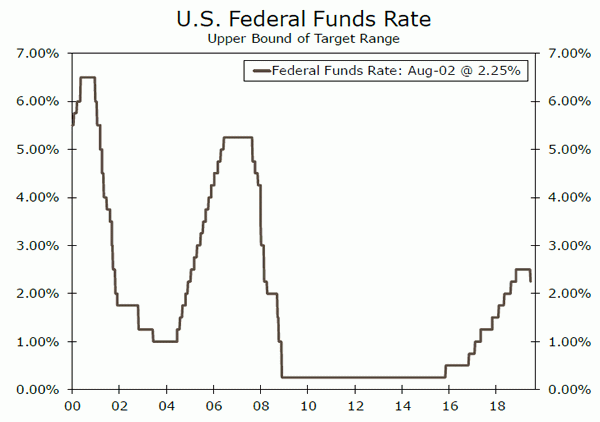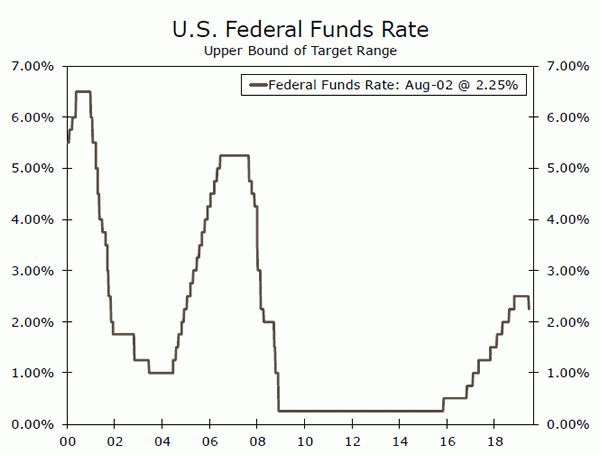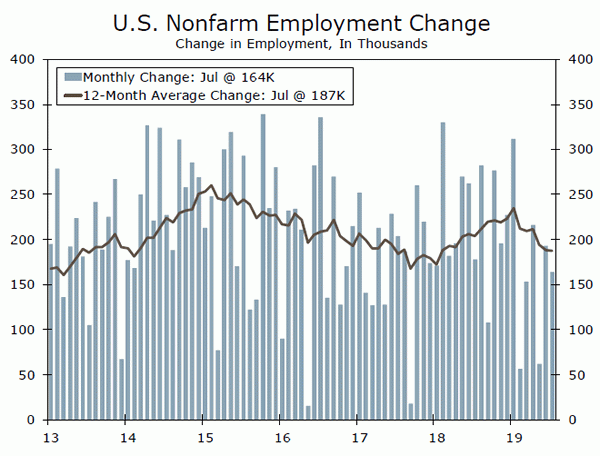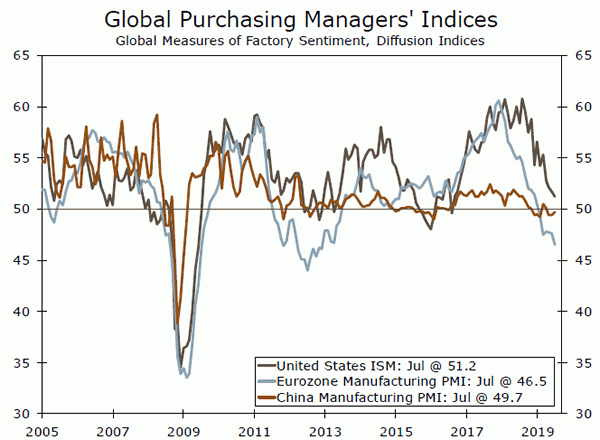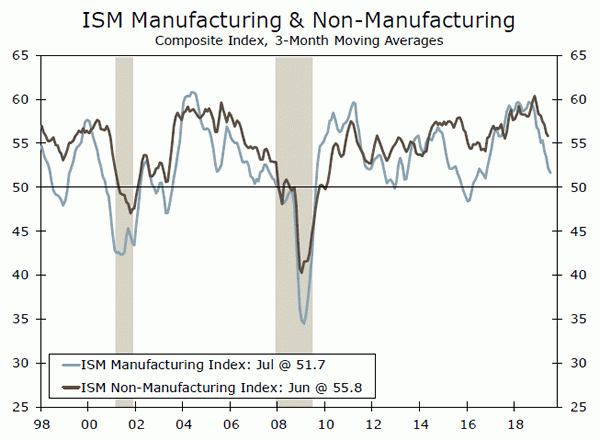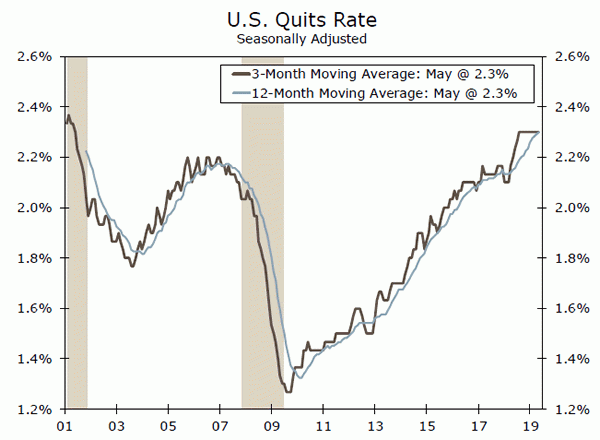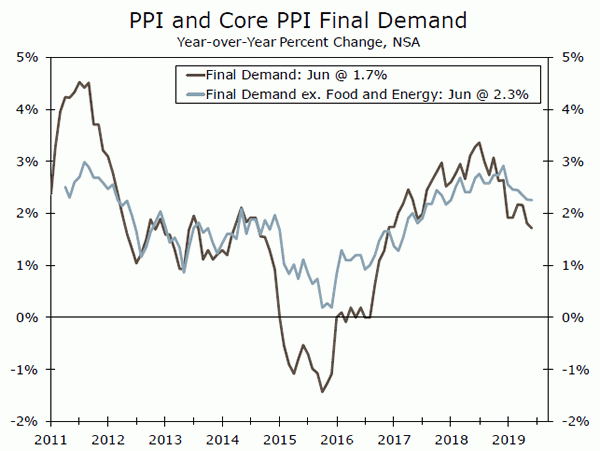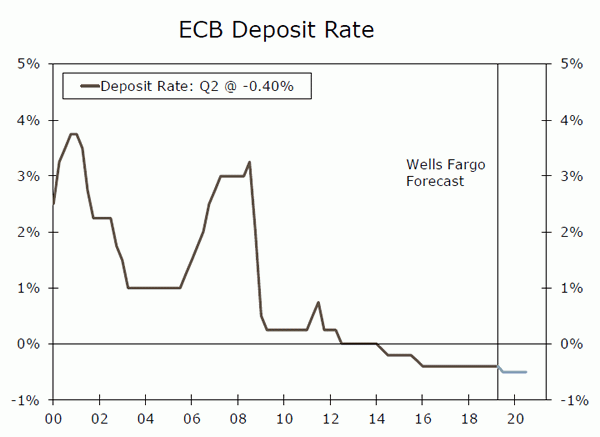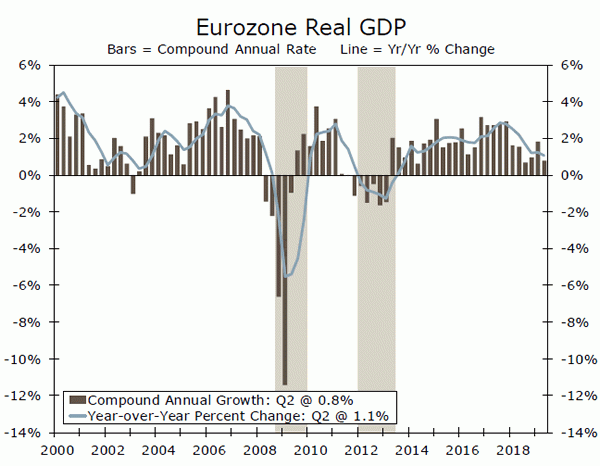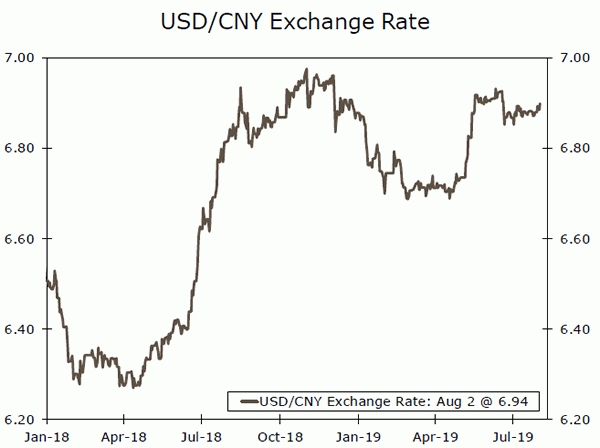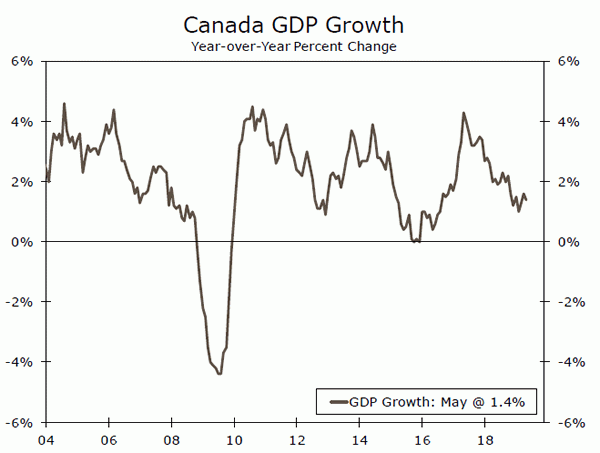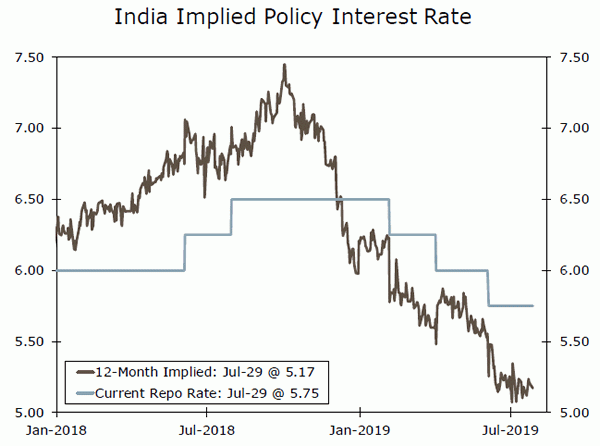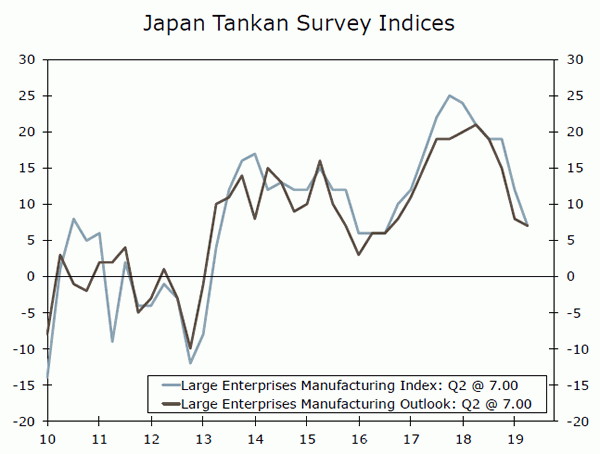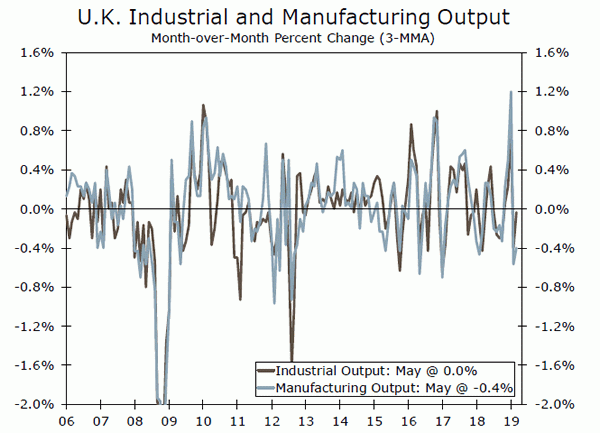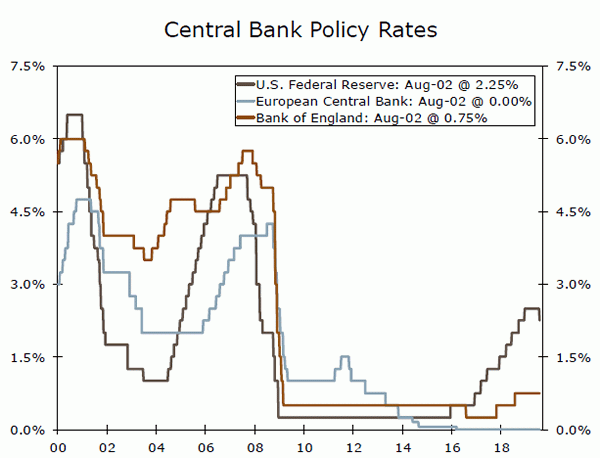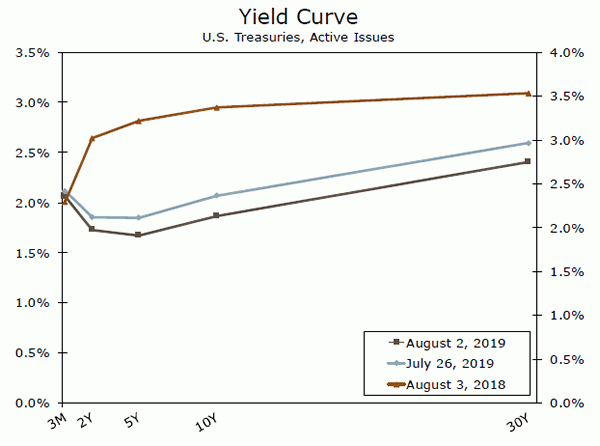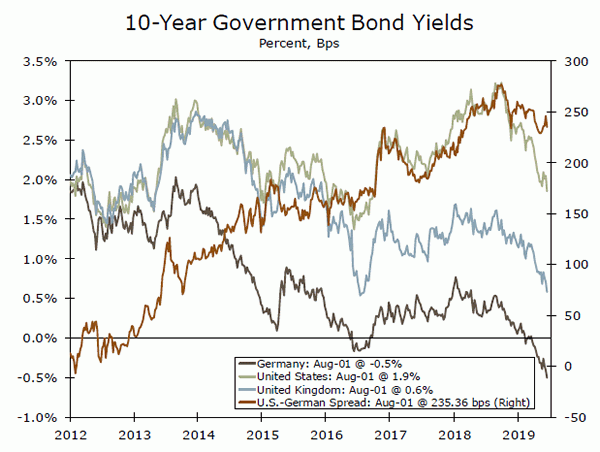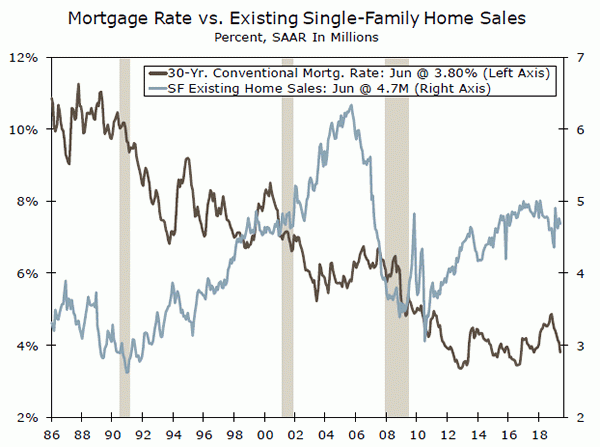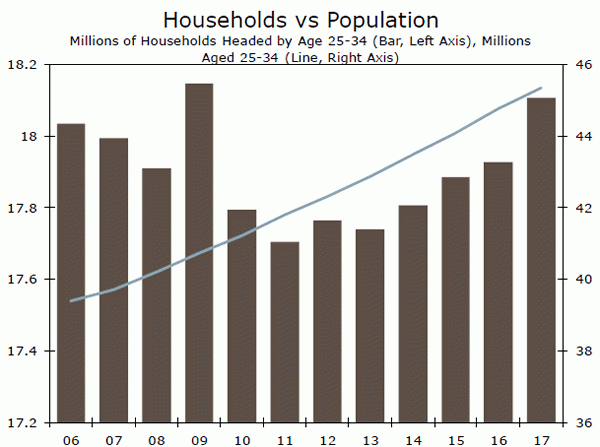U.S. Review
Fed Cuts, Trump Tweets
- The Fed cut rates this week for the first time since December 2008, in a move widely anticipated by financial markets.
- Powell termed the move a “mid-cycle adjustment” but also indicated that the Fed was not necessarily done cutting.
- Nonfarm payrolls rose 164K and average hourly earnings rose 0.3%, but that is not the Fed’s concern at the moment.
- President Trump announced he would proceed with a 10% tariff on the remaining $300 billion of Chinese imports, which sent the yield curve flatter and raised the probability that the Fed will be compelled to cut again this year, as we expect.
Fed Cuts, Trump Tweets
The Fed cut rates this week for the first time since December 2008, lowering the fed funds rate 25 bps to 2.25% in a move widely telegraphed by Fed officials and wholly anticipated by financial markets. Attention was more focused on the Fed’s next move, and whether or not 25 bps would be sufficient to “sustain the expansion.” Markets took the move as a mildly hawkish cut, with the yield curve flattening and equities falling in response. Chair Powell gave investors a lot to digest in his post-meeting press conference, particularly with his mixed messaging on whether or not this cut was the start of an easing cycle. Powell termed it a “mid-cycle adjustment” but also indicated the Fed was not necessarily done. We still expect the factors that necessitated this cut will compel the Fed to cut once more this year. Powell cited the “downside risks from weak global growth and trade policy uncertainty” and sub-target inflation as reasons to “insure” against an early end to the expansion.
The FOMC also announced that its balance sheet run-off would conclude in August, two months earlier than planned. We view this move merely as an act of policy consistency; the Fed would not want to have two of its policy levers pointing in opposite directions. Two committee members—Esther George and Eric Rosengren— dissented, likely in recognition of the strong 4.3% rise in personal consumption in Q2 and continued labor market strength.
In that regard, nonfarm payrolls rose 164K in July, right in line with market expectations and the FOMC’s characterization of the labor market as “strong.” The unemployment rate held at 3.7% and average hourly earnings rose 3.2% year-over-year, which is not enough to convince the Fed that inflation is set to rise meaningfully higher. Of greater concern is the domestic factory sector. The ISM manufacturing index fell to 51.2, still positive but close to stalling as the global growth slowdown (note in the bottom chart that the Eurozone and China manufacturing PMIs are in outright contraction territory) and the cloud of uncertainty surrounding trade policy weigh on the sector. The Chicago PMI also fell to the lowest level since December 2015. Instead of reading too much into Powell’s Q&A comments, which whipsawed financial markets, we return to his claim that the Fed has “seen both positive and negative developments”. In short, Powell was likely genuinely unsure of the Fed’s next move, and he probably would like to be data-dependent.
He may not have a choice, as President Trump entered the fray on Thursday afternoon. The announcement of 10% tariffs on the remaining $300 billion of Chinese imports sent markets into a tizzy, as the 10-year fell 14 bps in two days to a three-year low of 1.9%. Such tightening in financial conditions—falling equities and a flattening yield curve—may compel the Fed to cut again. Powell can take the personal vitriol (“As usual, Powell let us down”), but tariffs have a tangible effect on business confidence and investment and may force his hand. He has the unenviable task of balancing an outlook for the economy that he insists remains “favorable” with the significant uncertainty from the U.S.-China trade war. The Trump-Xi-Powell game goes on.
U.S. Outlook
ISM Non-Manufacturing Index • Monday
If you are looking for signs of a slowdown in the U.S. economy, look no further than the Institute for Supply Management’s purchasing manager indices. After topping out around 60 in the late summer/early fall of 2018, both the manufacturing and non-manufacturing PMIs have been on a steady downward descent. The manufacturing index has fallen farther than the nonmanufacturing index, a trend that has played out elsewhere around the world of late, especially in Europe.
From 2014-2016, a similar dynamic played out, as the U.S. economy as a whole slowed, but the slowdown was particularly concentrated in the manufacturing sector. During that period, a three-month moving average of the ISM non-manufacturing index never got below 53.5. Today, the non-manufacturing PMI sends a similar signal: economic growth is slowing, but the service sector likely remains strong enough to keep the overall economy afloat.
Previous: 55.1 Wells Fargo: 55.3 Consensus: 55.5
JOLTS • Wednesday
As can be seen in the chart to the left, the quit rate for the U.S. labor market is tightly correlated with the economic cycle. The quit rate measures voluntary separations between workers and their employers. When there is minimal slack in the labor market, workers feel more confident in their ability to quit their jobs and successfully land new opportunities. During downturns, however, workers quit their jobs at far lower rates, as individuals may feel less confident in their ability to find another job in a weak economic environment.
This cycle, the quit rate has been on a gradual ascent and last summer it touched a cycle-high of 2.3%. Since June 2018, however, the quit rate has been stuck, not deviating in either direction for 11 consecutive months. This lack of movement in the quit rate is yet one more example of an economic data point that is flashing yellow, but not necessarily red or green.
Previous: 7.3M Job Openings
Producer Price Index • Friday
Like other inflation measures, growth in the producer price index has slowed this year. On a year-over-year basis the PPI for final demand is up just 1.7%, the lowest reading since January 2017. Excluding food and energy, price pressures are a bit more firm, but they have still decelerated since the start of the year. The “core-core” PPI, which excludes food, energy and trade services (measured in margins), increased 2.1% year-over-year in June, down from a recent high of 3.1% in September 2018.
Tame price pressures in the pipeline are consistent with other readings. For example, the prices-paid component of the ISM manufacturing index was 45.1 in July, the lowest since February 2016. If PPI inflation were to slow further, it would likely reinforce markets’ views that this week’s rate cut by the Fed will not be a one-and-done move. Our forecast is for one more rate cut this year, and for inflation to eventually pick up around the end of the year.
Previous: 0.1% Wells Fargo: 0.1% Consensus: 0.2% (Month-over-Month)
Global Review
GDP Paints a Mixed Picture, While Tariffs Come Back
- The broader European economy remains subdued, with Q2 GDP and inflation data relatively underwhelming. In light of a persistently weak Eurozone economy, we maintain our view that the ECB will cut rates in September and now believe it will restart its asset purchase program in October.
- As noted above, President Trump elevated trade tensions with China this week. Trump stated tariffs will be imposed September 1st, while China has already indicated it will respond with necessary countermeasures.
Eurozone Growth Remains Subdued, Easing Coming?
The economic slowdown in the Eurozone has been underway for some time now, with this sluggish momentum carrying over into Q2. This week, Eurozone GDP was relatively underwhelming, with the broader European economy expanding just 0.2% quarter-overquarter. While this growth was in-line with consensus forecasts, it represents a sharp slowdown from Q1, where the Eurozone grew 0.4% quarter-over-quarter (top chart). Earlier in the week, individual countries within the Eurozone released Q2 GDP figures as well, with many of the larger European nations experiencing slowdowns. France, Spain and Italy all decelerated in the second quarter, while Germany is also forecasted to slow when Q2 GDP is released in mid-August. As the Eurozone growth outlook continues to deteriorate, it is likely that the ECB will move forward with a policy rate cut in September. We maintain our view that the ECB will cut rates in September; however, we now believe the ECB will restart its asset purchase program and begin purchasing €45B of sovereign bonds per month starting in October.
Trump Reignites U.S.-China Trade Tensions
Late this week, President Trump escalated trade tensions with China and injected new volatility into global markets, as the likelihood of a full-scale trade war between the two countries has increased. Trump stated he will impose a 10% tariff on the remaining $300 billion of Chinese exports to the United States on September 1st, citing Chinese authorities “not going fast enough” to finalize a comprehensive trade deal. Chinese authorities have indicated they will respond with necessary countermeasures, although details of these countermeasures are unclear at this time. In the immediate aftermath, global markets sold off sharply, with the Chinese renminbi reversing course and approaching the psychologically important CNY 7.00 level against the U.S. dollar (middle chart). As of now, we believe the People’s Bank of China will intervene in currency markets in an effort to stem the depreciation of the Chinese currency. We also believe Chinese authorities will introduce new stimulus measures to offset the impact of these additional tariffs should they be imposed, although downside risks to our GDP and inflation forecasts have increased.
Canadian Economy May Be Starting To Recover
Following a sharp deceleration in 2018, the Canadian economy may be starting to shows signs of recovering. Economic activity and sentiment data have been gradually improving over the last two months, culminating in a May GDP print of 1.4% year-overyear growth, beating analyst expectations for 1.3% growth, while April GDP was also revised higher to 1.6% (bottom chart). While risks to the Canadian economy are still prevalent, we believe the Canadian economy has bottomed out and is now on the path to recovery. Higher oil prices have assisted with the recovery, while uncertainty over future trade relations with the United States has started to diminish. As of now, we still expect the USMCA trade agreement to be ratified by the end of the year, which should also lift some lingering uncertainty over the economy and help the recovery. As the Canadian economy improves, we believe the Bank of Canada may start to become more hawkish and once again consider tightening monetary policy.
Global Outlook
Reserve Bank of India • Wednesday
India’s economy has been decelerating for some time now, with GDP growth trending lower over the course of the last-year-and-a-half. India’s slowdown was highlighted in Q1 of this year, with GDP slowing to 5.8% year-over-year, the first instance of growth falling below 6% since 2014. Over the last few months, India’s deceleration has been slightly more pronounced. Manufacturing and services PMIs both declined in June, with the services PMI now falling into contractionary territory, while industrial output has softened as well. In response, the Reserve Bank of India (RBI) has been cutting policy rates in an effort to stimulate the domestic economy. The RBI has cut policy rates three times this year, with our internal assessments suggesting the RBI has more room to ease monetary policy. In our view, India’s central bank will move forward with another 25 bps rate cut next week, and will look to cut rates at least one more time before the end of the year.
Previous: 5.75% Consensus: 5.50%
Japan GDP • Thursday
Following surprising growth of 2.2% QoQ annualized in Q1, the Japanese economy has showed signs of slowing down in Q2. In late June, the Tankan survey, an index used as an indicator of GDP growth, suggested GDP in Japan may be underwhelming in Q2. The large enterprises manufacturing index and outlook softened from Q1, while the small enterprises manufacturing index and outlook contracted in Q2. Leading economic activity indicators have also been relatively subdued, in particular industrial output. Industrial production has contracted the last five months, with output falling 4.1% YoY in June, a much sharper decline than what consensus forecasts suggested. In response to a decelerating economy, the Bank of Japan (BoJ) has suggested further monetary easing may be warranted. While we do not expect the BoJ to make any policy adjustments at this time, a sharper-than-expected slowdown in Q2 could push the BoJ to take a more dovish stance.
Previous: 2.2% Consensus: 0.6% (Quarter-over-Quarter, Annualized)
UK GDP • Friday
While the UK economy managed relatively strong growth in Q1, the economy could experience a notable slowdown in Q2. The strength in Q1 was likely a result of activity being brought forward ahead of the original March 29 Brexit deadline. Now that the deadline has been extended to October, it is doubtful the economy will be as strong in Q2. Over the past three months, leading indicators of economic activity have started to soften, with industrial production underperforming against consensus forecasts, while manufacturing production contracted 4.2% month-over-month in April and missed expectations in May. With Boris Johnson now the Prime Minister, there is also an increased likelihood that the UK will leave the EU without a Brexit deal. In the event a no-deal Brexit materializes, we would expect a significant downturn in economic activity and expect the UK to fall into a severe recession, which could lead the Bank of England to start cutting policy rates.
Previous: 0.5% Consensus: 0.0% (Quarter-over-Quarter)
Point of View
Interest Rate Watch
Tariff Tweet Trumps Fed’s Rate Cut
As expected, the Federal Reserve cut interest rates this week. The move went over like a lead balloon, however, as there were two notable dissents–Rosengren and George. The Fed’s message, while not quite one-and-done, was essentially one-andlet’s- wait-and-see. The markets had already priced in two or three quarter-point cuts and were understandably disappointed. The yield curve flattened after the Fed’s announcement, as the long end rallied and the short end was little changed.
President Trump was not pleased with the Fed’s performance and sent out a tweet that afternoon. The president made an even bigger splash Thursday afternoon, however, when he announced the United States would place a 10% tariff on the remaining $300 billion of Chinese imports not covered by tariffs already. The tariff tweet set off a much larger market response than the Fed did, sending the yield on the 10-year Treasury well below 2.00% and bolstered expectations for another rate cut in September or October.
The Fed’s actions this week are understandable given current economic conditions and lingering uncertainty about events overseas and how other central banks will respond to them. If it were just the economy, the Fed would likely be content to stand pat. Slowing global growth and the expansion of the trade war with China have increased uncertainty and will likely continue to weigh on growth in nations most exposed to international trade– namely Germany and Japan. The Fed also must contend with continuing QE at major central banks overseas, which has pulled interest rates further into negative territory in Germany, Switzerland and Japan. Those lower rates have caused the dollar to strengthen, which will help keep a lid on inflation even with the expansion of tariffs in September.
The Fed has three more meetings this year on September 18, October 30 and December 11. We continue to expect another quarterpoint cut in the funds rate this fall. The likelihood that Brexit will finally occur is another huge ambiguity policymakers must contend with that biases interest rate risks to the downside.
Credit Market Insights
Fed Easing and Consumer Spending
The current U.S. consumer debt profile may make Federal Reserve rate cuts, including Wednesday’s 25 bps cut, less effective in today’s cycle. Typically, fed funds rate cuts spur consumer spending as reduced financing costs free up cash flows, which can then be a potential tailwind for spending. However, the household debt categories that have grown since the recession, student and auto loans, have consumers locked in to fixed rates, which will not change with a cut. Student loans have grown to the second largest category of household debt, and auto loans have grown to a record share at 9.4%. Credit card debt is even smaller than it was in the prior cycle, at 6.2%.
Mortgage debt still contributes the most to household debt and makes up 67.6% today. Mortgage rates move more with the 10-year Treasury than the fed funds rate. Variable mortgage rates have also declined. Only 5% of mortgages have adjustable rates today compared to roughly 30% during the last recession, meaning considerably fewer households will find relief due to lower interest payments from lower rates. Rate cuts won’t likely stimulate home sales much as high mortgage rates are not the main obstacle to home buying. More affordable homes are needed to boost sales.
As we’ve already expressed, household debt is not a grave issue at the moment. That said, the growth in fixed-rate debt categories limits a rate cut from providing the same spending boost as it has in the past. For more information, reference our report.
Topic of the Week
Housing Demographics Turn More Positive
Lower mortgage rates have not yet proved to be a panacea for the housing market, but should boost sales later this year. While mortgage applications have risen, demand for new and existing homes has been mixed at best. The lack of improvement is not all that surprising. The second half of 2018 saw sales progressively weaken, as interest rates rose more than expected, which means home sales began 2019 well below where they were this time last year. With interest rates now falling, both new and existing home sales should rise modestly on year-over-year basis, even if they merely remain at their current pace.
One of the greatest hurdles to a stronger housing recovery has been lackluster household formation. Household growth slowed to less than 600,000 per year from mid-2009 to mid-2011, before picking up 1.4 million per year according to the latest data. Measuring households is imprecise, however, and we believe actual household growth is now somewhere around 1.2 million per year.
After trailing population growth for several years, household growth among young persons has ramped back up in line with population. Homeownership should also get a boost as more Millennials approach major life milestones. While starting a family typically is a major catalyst for home buying, Millennials are waiting longer to have children. Even after having a child, many are content to remain in apartments. Eventually celebrating their children’s birthdays at breweries will grow old and more Millennials will migrate to the suburbs, boosting demand for starter homes. The shift may be more gradual than many expect, however.
Overall, the improved economic and demographic environment, coupled with lower interest rates, should produce a more favorable environment for home sales, new home construction and apartment demand. Both owner and renter households grew solidly over the past year, resulting in fewer vacant homes for-sale and forrent. While affordability challenges will likely continue to keep many renters in apartments for longer, a rising number are now looking to buy.




